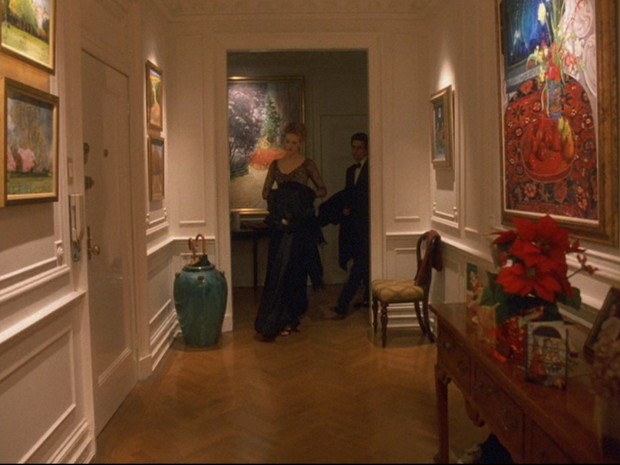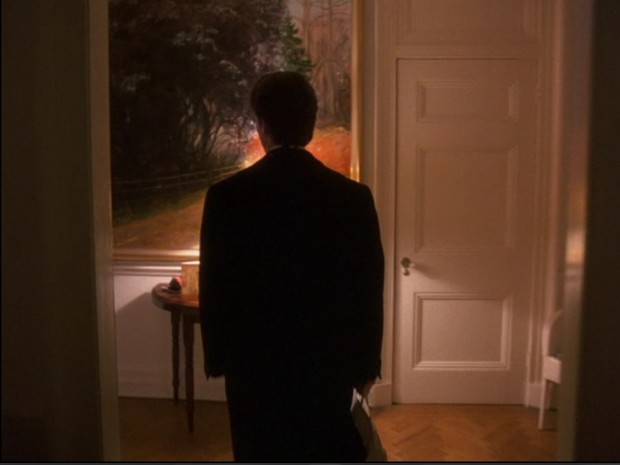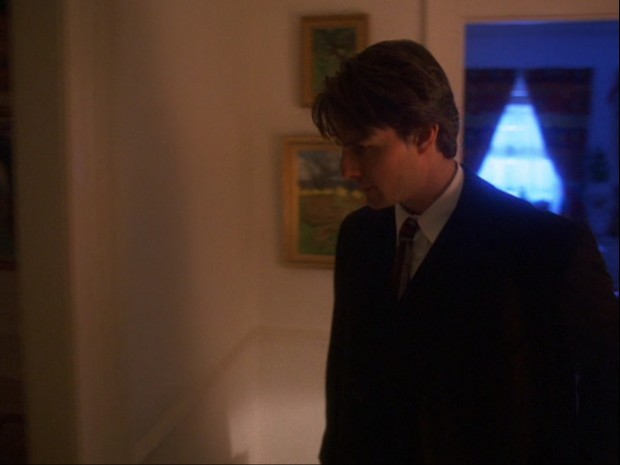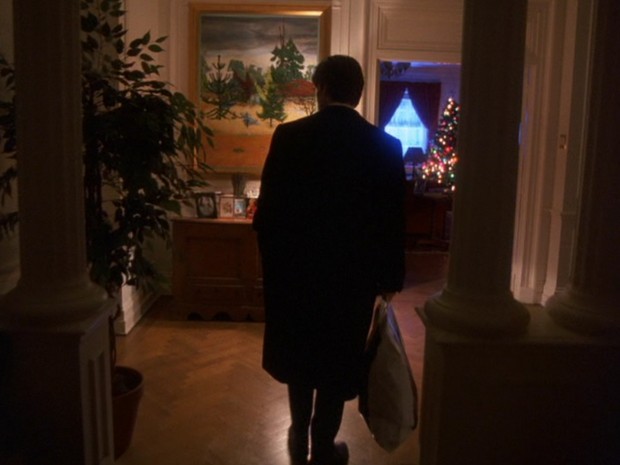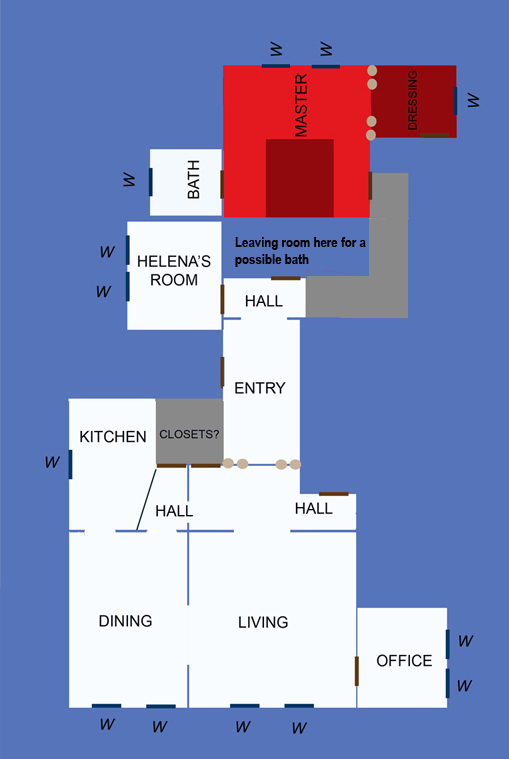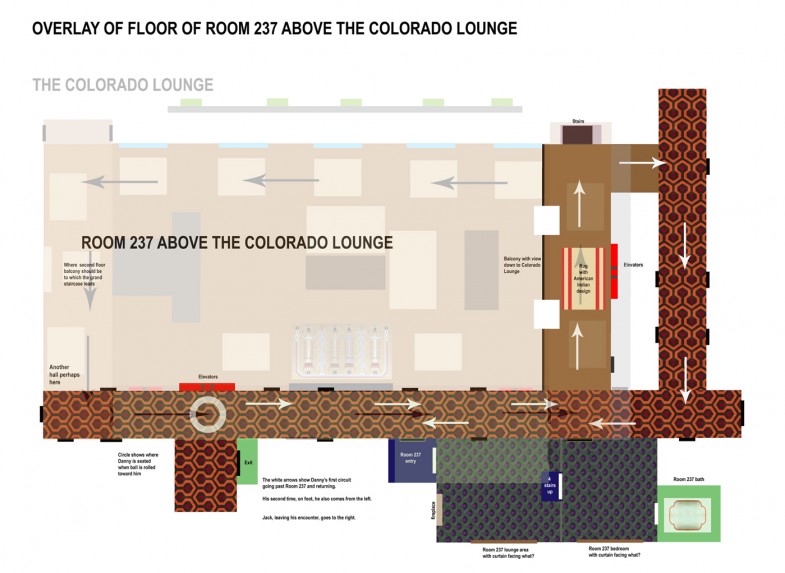Kubrick's Eyes Wide Shut:
The Impossible Relationship of the Harford Bedroom to the Apartment and Why it Matters
Go to TOC for this film ( (which has also a statement on purpose and manner of analysis and a disclaimer as to caveat emptor and my knowing anything authoritatively, which I do not, but I do try to not know earnestly, with some discretion, and considerable thought).
The first time we see the Harford's exit their bedroom, toward the beginning of the film in shot 8, we are given a view of the hall outside. As they exit, they go down the hall to the right, then we have a cut-away to the next shot.
In shot 9 we then have the Harford's entering the long hall of their entryway. We hear the click of the bedroom door shutting behind them.
Kubrick thus establishes for us that the Harford bedroom, in shot 9, is to the right in the hall at the end of the entry gallery, and that if we entered that hall from the gallery the bedroom door should be facing us. The door should be beside the door we see in shot 9, in the shadows beside the spot-lit painting of a woodsy scene.
We do not encounter this hall again until Bill returns home from Somerton. He approaches it and does not look to the right, toward where we have been led to believe is the door to his bedroom, next the observed door. He does not so much as glance in the direction of screen right. Instead, he turns left in the hall and checks on Helena in her bedroom, its position in relationship to the rest of the apartment now revealed.
Note that a white chair is now situated to the right in the hall, which seems would perhaps block that end of the hall and thus the entry to the bedroom.
Again, when Bill leaves Helena's bedroom, he does not so much as glance up toward the end of the hall where Kubrick had initially led us to believe the bedroom was located. He turns back into the gallery entry.
Bill continues down the gallery entry to the living room, and upon reaching the hall that separates the entry from the living room, he glances left. The message given the viewer is that he is checking to make sure that he will not be seen by Alice when he goes into the office to hide the Rainbow bag with its mask.
After having hidden the mask, when Bill is shown entering the bedroom it is through the same door as he had first exited it with Alice the night of the party at Victor's. This is the door that is consistently used in the film. We are not shown Bill walking through the apartment to the bedroom. Though we are directly shown the relationship of the apartment to Helena's bedroom, we are never shown directly the relationship of the apartment to the master bedroom.
When Bill returns home from his billiard room meeting with Victor, he does not look toward the hall where Kubrick first instructed us the bedroom should be. Instead, Bill approaches the living room and glances left again as he passes by the hall that separates the entry from the living room. Again, he is checking to see if a door is open, to make sure that Alice is asleep and he is unobserved.
In the shadows, we see the barest glimpse of the shade of a lamp, which means there is a table in that hall, just as there is a lamp on a table outside the entry to the master bedroom.
Assured that Alice is asleep, he goes into the kitchen, pops open a beer, and gets a bit sloshed. Guy's had a hard night.
Indeed, if one gives some thought to the apartment, how the master bedroom, the dressing room and master bath fit in, the suite is impossible to place.
First off, we have been shown what we are supposed to imagine is the exterior of the Harford's apartment building, in which they reside on the fifth floor.
It is a massive building. However, as we shall see, the Harford apartment has windows facing north, south, east and west, all directions, which is impossible for such a large building. They certainly don't occupy a full floor.
Now, to examine the layout of the apartment and the two possible and both absolutely impossible relationships of the Harford bedroom to it.
The gray areas of my diagram are guesses, and there are other areas as well which are never seen or are difficult to lay out, but much can be plotted with certainty.
The first layout in the above image shows where the bedroom would be if it is in the position that Kubrick first shows it to be at the film's beginning--down the right to the hall and at its rear. What makes this plotting absolutely impossible, even not taking into consideration that it must occupy an entire floor, is the fact the dressing room has a window on a wall that is interior to the apartment rather than being exterior.
As we observe, the layout of the apartment demands exposure on all four sides.
The second layout in the above image shows the relationship of the apartment to the bedroom if we move it so that the bedroom's primary entrance is instead off the hall between the living room and the entry. This goes against what we were shown at the film's beginning, but I am showing that relationship anyway as twice Bill looks toward that hall, making sure Alice in their bedroom is unaware of his arrival home. Again, we see that this positioning of the bedroom is impossible in relationship to the rest of the apartment. The dressing room's window is on an interior wall rather than an exterior one.
Even if, as shown in the below image, we turn the bedroom 90 degrees counter-clockwise so that its primary door opens on yet another unseen hall, that is still an untenable arrangement.
Most importantly, our gut extinct at the beginning is not that the Harfords leave the bedroom and turn a corner into Helena's hall, then go into the entry gallery. Our gut instinct, what Kubrick tells us at the beginning, is that their bedroom is off the same hall as Helena's.
What if the viewer says, "Well, there is a door that leads off the dressing room, and I thought that Bill was checking the dressing room door on his way to the living room"? The below diagram shows what happens if we position the dressing room door so that it is the one that is off the hall between the entry foyer and the living room, the bedroom suite ends up occupying the entry foyer, as well as parts of the kitchen and living room.
In an interview, Nicole Kidman said that Kubrick designed the Harford home so that it was an "exact duplication" of his apartment before he left New York for England, even the furniture. I would imagine this supposed "exact duplication" was of the apartment the Kubricks were living in at 84th and West Central Avenue when filming of 2001 was begun, as by the time it opened they were in a mansion (I read) and then they moved forever to England after some years of a transition that had begun even before 2001, during Lolita.
It seems a stretch to say the apartment would have been decorated as one in the 60s had been, down to the furnishings, but perhaps to the degree that the 90s permitted and wouldn't look odd. If Nicole and Tom believed this story to be absolutely true then their characters were effectively, for them, living in a former apartment of Kubrick's, via the duplication, and one wonders what effect that would have on their performances. As for Kubrick, if this is partly true, he would have been returned to a very personal geography and perhaps memories of 2001. Also, this would have mixed with childhood memories, as his father was a physician, as is Bill.
The fact remains that, as with households in Lolita and The Shining, our perception of the layout has been purposefully thrown off. We are presented with different versions of the apartment and none of them are entirely rational. For the apartment to have an irrational layout is one thing, but for it to change is another.
Why does it at all matter, even the slightest bit, that it seems impossible to orient the Harford's bedroom in relationship to the rest of the apartment? Well, it matters because first Kubrick gives us an indication of where it should be and then shows Bill relating with it differently. It matters because every other room we are shown of the apartment--the living room, the dining room, the kitchen, the halls, the office, Helena's bedroom--are all explicitly stated, we are shown the Harfords entering or exiting these rooms without cut-away shots so we know exactly how these rooms are positioned in relationship to each other. Yet the Harford's bedroom, arguably the most important area of their apartment in respect of this film, as that is where they sleep and dream, is never viewed in relationship to the rest of the apartment. The camera never follows them from another area of the apartment into the bedroom. Instead, there is always a cut-away, and we are shown only a tiny bit of hall outside their bedroom door when the bedroom is exited or entered.
Kubrick purposefully disorients the viewer, even if we're unconscious of it, even if we accept what we are shown, what we are supposed to believe, because the Harfords are at ease with their apartment, just as the Torrance family is at ease with the Overlook Hotel that abounds with impossible geographical relationships. Indeed, the viewer is intended to believe what is suggested as being real (no matter how irrational), and then Kubrick tosses in irritants that grate the flesh of the snail in its shell. If the viewer is not at all consciously aware of some disorientation, Kubrick makes certain to show us we should be questioning what's going on with the bedroom by having Bill check on the door off the hall between the entry and the living room, something Kubrick need never have had him do, and he has him do it not just once but twice.
Eyes Wide Shut, as with The Shining has its share of peculiar and impossible spatial relationships. The viewer struggles over the big mysteries of the film, often ignoring others which that are not simple continuity errors. Kubrick would not have us question the position of the Harford's bedroom in relationship to the apartment by having Bill twice check the door off the hall between the entry and the living room if we were supposed to be simply accepting whatever Kubrick threw at us via the agreement between the film and the viewer to allow simple suspension of disbelief. Instead, he is instructing the viewer on how to watch his films, to examine and re-examine them, to question once, twice, what is there on the surface, what we think the projected reality to be.
Bill's not looking at all down the hall in the direction of where his bedroom supposedly is, not even giving it so much as a glance, is much like the scene in The Shining when Danny, entranced by Room 237, dismounts his Big Wheel to try the door, then getting back on his trike and cycling down the hall stubbornly keeps his eyes down and averted from the plainly open door across the hall.
If he looked, he would only find there's no room there. In Danny's circuit of the second floor, just shown, Kubrick plainly showed there were no rooms, no space for them, to go with the doors on the right side of this hallway, that there is only air on the other side, the spacious upper reaches of the Colorado Lounge.
What that open door might mean for the character of Danny, who doesn't see it, is one thing. What that open door means for the audience, who doesn't see it, is entirely different. The open door is obviously there, and yet through Kubrick's sleight-of-hand magic the audience overlooks it. The audience, not seeing the open door, can't question what meaning that open door may have for the character of Danny, as they themselves don't know it's there though it is open in plain sight. Upon realizing the door is open then not only is the question of what that open door means to Danny to be asked, but what it means for the audience, who were plainly shown the door and didn't see it.
Which is why it's important to question these fundamental and peculiar mysteries in Kubrick's films, such as the problem of the Harford's bedroom.
When you finally see what's been there all along right in front of your eyes, you realize there's much more to the film than what's in front of your eyes. Kubrick's films are littered with many such opportunities to bring attention to this fact.
2280 words or 5 single-spaced pages. A 18 minute read at 130 wpm.
Go to Table of Contents of the EWS analysis
Link to the main film page for all the analyses


